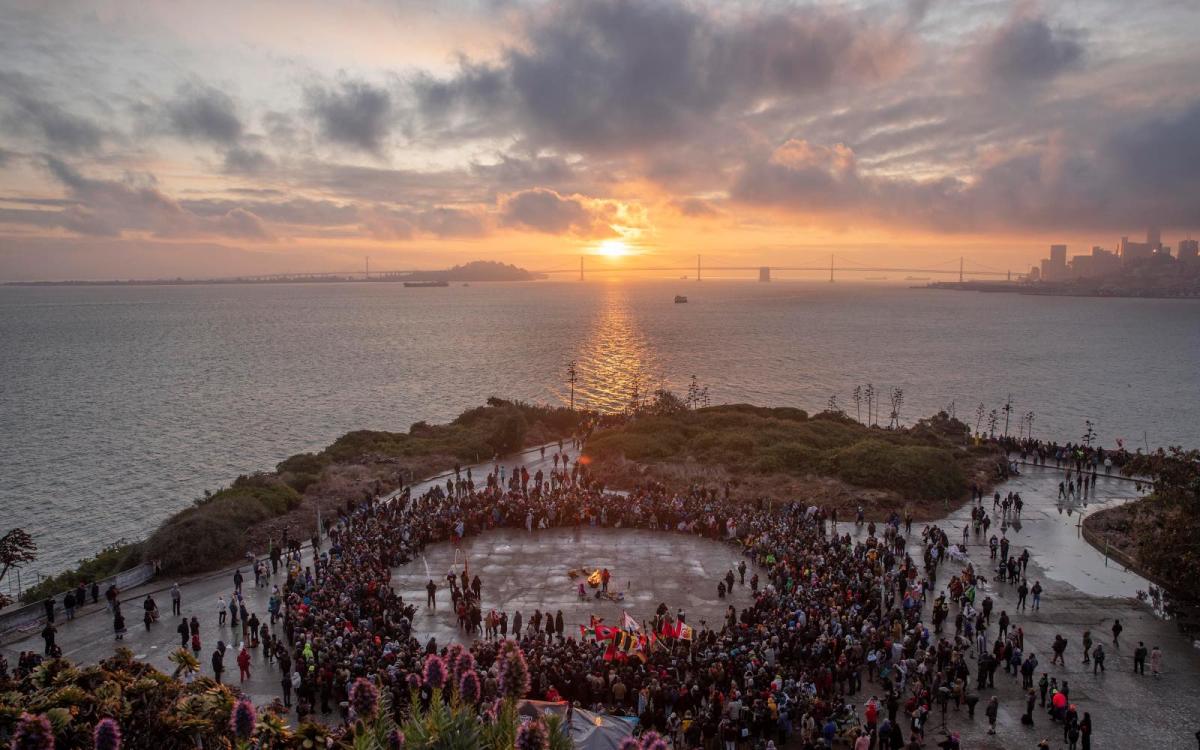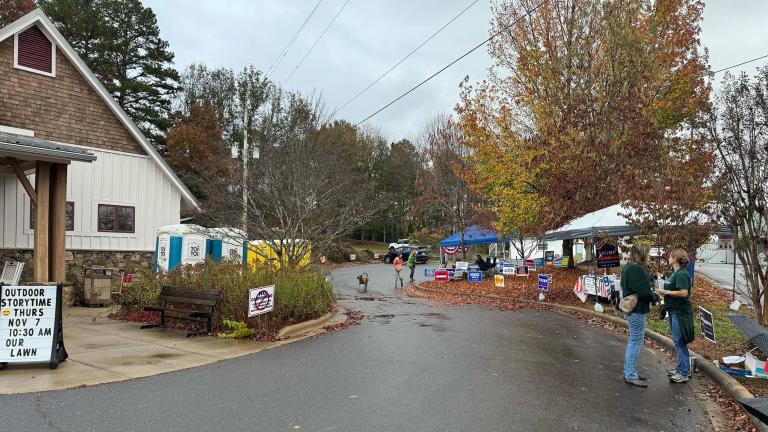
The vision
“This one day a year doesn’t suffice for the gratitude and appreciation that we have for our plant, animal, water, and land relatives. Our way of life is a thanks giving, every day.”
— Lucy Suppah, of the Native American Youth and Family Center
The spotlight
The further I drive into the hills, the more breathtaking the Wind River Reservation becomes. Twilight brings a big pink sky, the nearby creek has mule deer and pheasants scattered around its bank, and the silence is so complete in the cool air I feel like an interloper, despite living around here my whole life.
I’m headed to the home of Eastern Shoshone elder Caroline Mills, which is nestled between rolling sagebrush hills that slowly grow in height until they become the Wind River Mountain Range. When I arrive, I’m welcomed into her cozy abode, and soon I’m sitting on her couch with a hot cup of tea made from hawthorn berries she personally gathered.
She’s a part of Restoring Shoshone Ancestral Food, an organization that is reclaiming knowledge of Shoshone foods by collecting native plants like bluebells, chokecherries, and biscuit-root, and learning how to prepare them. “We’ll walk around, dig up a wild onion, munch on that, and learn about plants,” she says.
I’m here to talk with her about Thanksgiving — a holiday that we both do not like.
“I’m thankful to have fresh air, good water,” she says. “And no traffic.” We laugh. Traffic in Wyoming has more to do with cows than cars. We share that we both love getting together with those we love, eating good food, and being grateful for what we have and giving what we can. But, as Mills puts it, “As Shoshone, our land was taken, our way of life was taken, and they tried to assimilate us into white America.”
For a long time I had a mantra around Thanksgiving: “It’s a genocidal holiday, but I’ll eat.” I’ve spent decades going to Thanksgiving meals, eating my fill of dry turkey and sweet potato, praying to a white God I don’t believe in, and bouncing. There is immense societal pressure to celebrate this holiday, despite the terrible history that it represents. And, while the modern conception of Thanksgiving would appear to be about gratitude, the harvest, and the simple joy of sharing a meal with loved ones, the holiday kicks off a whole season of overconsumption and emphasizes an excessive, preset menu that is entirely divorced from what’s local and seasonal in most places.
But as more people have become aware of the Thanksgiving myth, and as more people are looking to live in the right relationship with land, rejecting the paradigm of extraction and waste, there is a growing interest in doing something else on the fourth Thursday every November. Spearheaded by Native groups that, like me, are looking to recognize the realities of what Thanksgiving commemorates, other options are available that offer ways to actually honor land, food, and Native traditions. Over the past few weeks, I spoke with Mills and others about what Thanksgiving means to them, and some of these efforts to recontextualize the holiday. And what I’m finding is that “thanks giving” can and should happen every day — dry turkey not included.
![]()
The idea for Thanksgiving as a national holiday emerged in the mid-1800s, drawing on a romanticized image of a harvest festival that took place centuries earlier at the first European colony in New England. But Native people have long been aware of how false that myth is, and it starts well before the arrival of the Mayflower. The Wampanoag people of Massachusetts were the first tribe to encounter the pilgrims, but the tribe had interacted with European settlers and enslavers prior to that, and had been decimated by a disease likely brought over by Europeans. “For us, the real story has to do with slavery. It has to do with sickness. … It has to do with cultural genocide; forced assimilation; language, traditions, culture ripped away from us,” Steven Peters, a member of the Mashpee Wampanoag who creates historical exhibits for the tribe, told Indian Country Today.
As a result, there is a history of Indigenous resistance during the time of year often associated with Thanksgiving.
Since 1970, tribes and allies have gathered on the fourth Thursday in November at Cole’s Hill in Plymouth, Massachusetts, for the National Day of Mourning. According to the United American Indians of New England, which organizes the event, this is a “solemn, spiritual, and highly political day,” where those gathered mourn the victims of genocide and the theft of Indigenous lands. A plaque in the town of Plymouth details the significance of the National Day of Mourning. The final sentence reads: “It is a day of remembrance and spiritual connection as well as a protest of the racism and oppression which Native Americans continue to experience.”
On the other side of the country, in San Francisco, thousands participate every year in the Sunrise Gathering on Alcatraz Island. When it was started in 1975, the event was called Un-Thanksgiving Day. It stemmed from an intertribal movement where tribes occupied Alcatraz Island in November 1969 and claimed it from the federal government under treaty right. The occupation ended in 1971, but it has inspired an ongoing movement of Indigenous resistance, including movements like the opposition to the Dakota Access pipeline in 2016 by the Standing Rock Sioux Tribe. And the annual gathering continues as a way to “honor our ancestors and give thanks for the survival of our nations, cultures, and ways of life.”
For the past three years, Portland, Oregon, has been home to another alternative for those seeking to recognize the realities of Thanksgiving. There, an Un-Thanksgiving event is put on by the Native American Youth and Family Center, or NAYA, an intertribal group that aims to strengthen the Indigenous community by promoting cultural identity and education. The center also hosts a community garden as a way to support the community with food as well as strengthen Indigenous foodways.

Volunteers work in the NAYA community garden during the group’s Un-Thanksgiving event last Thursday. Courtesy of Bonz Wykman
For NAYA, Un-Thanksgiving is a mourning of the atrocities and genocide that Native peoples have endured, but it also offers an opportunity for the Portland community to learn and help tend the intertribal community garden. Un-Thanksgiving includes teaching the history of Thanksgiving from a Native perspective, as well as an opportunity to plant, weed, and prepare the ground for growing food in the spring. When they started the event in 2022, organizers only expected around 40 people to attend. Instead, around 200 Native and non-Native people came. The event has grown every year, so much so that it now spills over into multiple days.
Lucy Suppah is an enrolled Warm Springs tribal member in Oregon, and is also Shoshone-Bannock. She helps grow food for the community at the center, and during one Un-Thanksgiving event she taught a group of around 60 people how to identify, pick, and weave spoons from bear grass. As part of the lesson, she told everyone that if she showed them how, they would not sell their creations, exploit the resource, or use the knowledge in any way that causes harm. “We talk about having a good mind and heart, especially when we’re working with our medicines or our culture,” she said, adding that it’s about being in good relationship with the land, and with each other.
Bonz Wykman, who’s not Indigenous, also manages the garden and says that they hope the event opens people up to learning more about Native foodways and being in solidarity all year long with tribal communities. “The land holds us all if we are coming at it in a good way,” they said. Since many businesses are closed on Thanksgiving, NAYA’s events also offer a space for people who have nowhere to go, or don’t want to do the typical excessive meal at home. “We are giving people the opportunity to experience something different,” they said.
Suppah has visited the Wind River Reservation many times before, so I asked her what people (like me) can do, who live in communities that don’t yet have events like NAYA’s Un-Thanksgiving. She’s originally from Fort Hall in Idaho, a rural, conservative place by comparison to Portland. She said one of the biggest lessons she brings to Un-Thanksgiving is that, for Indigenous peoples, everywhere and every day is a time to give thanks — whether or not there’s a holiday or a special event to go to.
“This one day a year doesn’t suffice for the gratitude and appreciation that we have for our plant, animal, water, and land relatives,” she said. “Our way of life is a thanks giving, every day.”
In other words, living in right relationship with land isn’t confined to a day or a particular event — but events like Un-Thanksgiving may provide an opportunity to spread that message to those willing to listen. This and the other events held throughout Native American Heritage Month put a spotlight on the history that contributes to the continued oppression of Indigenous peoples in the United States. As climate change threatens many of the natural gifts the land provides for us, Indigenous peoples look for justice and solidarity in a growing understanding of the continued era of colonialism and exploitation that Thanksgiving represents.
![]()
Back in Caroline Mills’ living room, I watch the sun set over the Wind River mountains. “How do you have gratitude during a holiday that’s taken so much?” I ask, angrily clutching the Garfield mug full of herbal tea.
“It’s the only day where we are even thought of,” Mills says. “It’s sad.” She agrees with Suppah, that the celebration of Thanksgiving every year has tended to omit the true story and the perspectives of Indigenous peoples, but it also doesn’t encapsulate the gratitude for what we do have. Being in good relationship with the pheasants and deer, sagebrush, and biscuit-root, and thankful for the gifts the land gives, is another way to practice an alternative to this colonial holiday. It’s a subtle but important difference from being grateful for items and food that divorce us from the gifts that lay right beneath our feet.
Mills gazes at the Wind River Range outside her window and smiles. She tells me that every year, she goes out and harvests berries or other medicines, and she sometimes ends up seeing more the next year. She says it’s because she harvests them in a good way; not taking too much, knowing when and how to harvest them.
“Every year I come back, and they seem to say to me, ‘Ah! There you are,’” she laughs. “It’s like they remember me. I’m grateful for that.”
— Taylar Dawn Stagner
More exposure
- Read or listen to: more about NAYA’s Un-Thanksgiving events in Portland (Oregon Public Broadcasting)
- Read: more about the annual Sunrise Gathering on Alcatraz Island (The Conversation)
- Read: an essay on Thanksgiving by Sean Sherman, aka The Sioux Chef (Time magazine)
- Peruse: Grist’s 2021 holiday makeover, offering an array of advice and alternative approaches to things like travel, gift giving, and food
A parting shot
A photo from the Sunrise Gathering on Alcatraz Island in 2019. The event itself is free and open to the public, but ferry tickets from San Francisco regularly sell out — this year, around 5,000 people attended the gathering.



